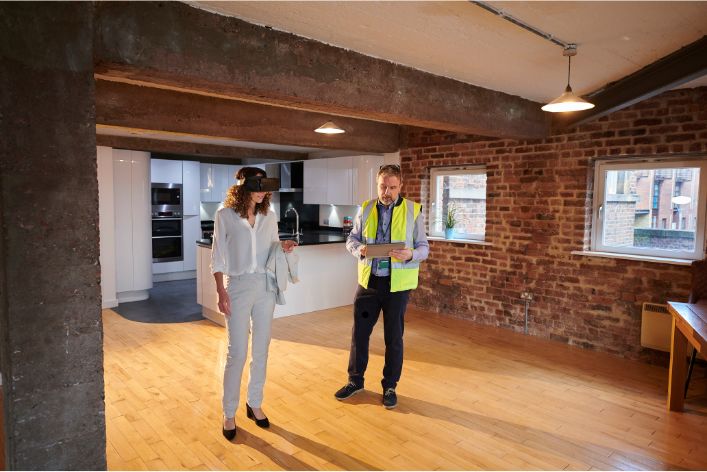Introduction
Real estate virtual tours are rapidly transforming online listings.
According to a recent survey, 75% of buyers now prefer virtual tours before visiting a property in person.
This growing trend highlights the significant impact of technology on the real estate market.
Virtual tours offer an immersive and interactive experience that traditional listings can’t match.
Unlike static photos, virtual tours provide a 360-degree view of properties.
This allows potential buyers to explore every corner from the comfort of their own homes.
The Power of Virtual Tours
Virtual tours revolutionize online real estate listings in several ways:
- Enhanced Viewing Experience
- Buyers can virtually walk through properties.
- They can view details from various angles.
- Buyers can virtually walk through properties.
- Convenience and Accessibility
- Buyers can access tours anytime, from anywhere.
- No need to schedule multiple in-person visits.
- Buyers can access tours anytime, from anywhere.
- Informed Decision-Making
- Buyers get a realistic sense of the property layout.
- They can make more confident purchasing decisions.
- Buyers get a realistic sense of the property layout.
Why Virtual Tours Matter
Virtual tours benefit both buyers and sellers.
For buyers, they provide a comprehensive view of properties, reducing the risk of surprises during in-person visits.
For sellers, virtual tours attract more qualified leads and reduce time on the market.
Buyers can spend hours exploring a property virtually, leading to higher engagement.
Sellers can showcase their properties in the best light, highlighting unique features and amenities.
This modern approach enhances the overall real estate experience.
The Future of Real Estate Listings
Virtual tours represent the future of real estate listings.
They are becoming the new standard for property presentations.
As technology advances, we can expect even more immersive and interactive experiences.
- Virtual Reality (VR) Integration
- VR headsets will offer fully immersive tours.
- Buyers can experience properties as if they were physically present.
- VR headsets will offer fully immersive tours.
- Augmented Reality (AR) Enhancements
- AR will add interactive elements to tours.
- Buyers can visualize furniture placement and décor options.
- AR will add interactive elements to tours.
Virtual tours are not just a trend; they are here to stay.
They are revolutionizing the way we view and interact with real estate listings.
As the market evolves, embracing virtual tours will become essential for both buyers and sellers.
The Evolution of Real Estate Listings
The real estate market has witnessed a significant transformation in how properties are showcased.
From traditional listings with static photos and text to the immersive experience of virtual tours, the evolution has been remarkable.
Let’s delve into this journey, examining traditional listings and the emergence of virtual tours.
Traditional Listings
Traditional real estate listings relied heavily on photos and descriptive text.
Sellers and agents would capture images of various rooms and features.
These photos were then complemented by detailed descriptions.
This approach aimed to give potential buyers a sense of the property.
However, traditional listings had several limitations:
- Lack of Engagement
- Static photos and text fail to engage viewers.
- Buyers quickly lose interest in non-interactive content.
- Static photos and text fail to engage viewers.
- Incomplete Property View
- Photos often miss important angles and details.
- Buyers can’t fully grasp the property layout from images alone.
- Photos often miss important angles and details.
- Limited Perspective
- Photos provide a narrow view of rooms.
- Descriptions can’t convey the property’s true atmosphere.
- Photos provide a narrow view of rooms.
Traditional listings served their purpose for many years.
Yet, they left much to be desired in terms of buyer engagement and property representation.
Emergence of Virtual Tours
The emergence of virtual tours marked a new era in real estate listings.
Virtual tours offer an immersive and interactive experience, allowing buyers to explore properties in depth.
Brief History of Virtual Tours
Virtual tours began gaining popularity in the early 2000s.
Initially, they were simple, panoramic photos stitched together.
These tours provided a basic 360-degree view of rooms.
Over time, technology advanced, enhancing the quality and interactivity of virtual tours.
We Design & Develop Websites, Android & iOS Apps
Looking to transform your digital presence? We specialize in creating stunning websites and powerful mobile apps for Android and iOS. Let us bring your vision to life with innovative, tailored solutions!
Get Started TodayBy the 2010s, virtual tours had become more sophisticated and widely used in real estate.
Technological Advancements Enabling Virtual Tours
Several technological advancements have enabled the rise of virtual tours:
- 3D Cameras
- 3D cameras capture detailed and realistic images.
- They create high-quality, immersive virtual tours.
- 3D cameras capture detailed and realistic images.
- Faster Internet
- High-speed internet allows smooth streaming of virtual tours.
- Buyers can explore properties without buffering or lag.
- High-speed internet allows smooth streaming of virtual tours.
- Advanced Software
- Software advancements enable seamless tour creation.
- Editing tools allow for professional-quality virtual tours.
- Software advancements enable seamless tour creation.
- Mobile Compatibility
- Virtual tours are now accessible on mobile devices.
- Buyers can view tours on smartphones and tablets.
- Virtual tours are now accessible on mobile devices.
Impact of Virtual Tours
Virtual tours have revolutionized real estate listings in several ways:
- Enhanced Buyer Experience
- Buyers can explore properties from any location.
- Virtual tours offer a realistic sense of the property’s layout.
- Buyers can explore properties from any location.
- Increased Engagement
- Interactive tours keep buyers engaged for longer periods.
- Buyers can navigate through rooms at their own pace.
- Interactive tours keep buyers engaged for longer periods.
- Better Decision-Making
- Buyers can make informed decisions based on a comprehensive property view.
- Fewer surprises during in-person visits.
- Buyers can make informed decisions based on a comprehensive property view.
- Reduced Time on Market
- Properties with virtual tours tend to sell faster.
- Serious buyers are more likely to proceed with purchases.
- Properties with virtual tours tend to sell faster.
- Competitive Advantage
- Sellers using virtual tours stand out in the market.
- They attract more qualified leads and potential buyers.
- Sellers using virtual tours stand out in the market.
The evolution of real estate listings from traditional methods to virtual tours has transformed the industry.
Traditional listings, with their limitations, paved the way for the innovative and engaging experience of virtual tours.
Technological advancements such as 3D cameras, faster internet, and advanced software have made virtual tours a powerful tool in real estate.
Virtual tours enhance the buyer experience, increase engagement, and improve decision-making.
They also provide a competitive edge for sellers.
As technology continues to advance, the future of real estate listings looks even more promising with further enhancements in virtual tours.

Benefits of Virtual Tours for Buyers
Virtual tours have revolutionized the way buyers view and interact with real estate listings.
They offer numerous advantages that enhance the property viewing experience, improve decision-making, and increase engagement and retention.
Let’s explore these benefits in detail.
Enhanced Property Viewing Experience
Virtual tours provide an enhanced property viewing experience that traditional listings cannot match.
- 360-Degree Views and Immersive Experience
- Virtual tours offer a comprehensive 360-degree view of properties.
- Buyers can see every corner and detail of a property.
- This immersive experience makes them feel like they are physically present.
- Virtual tours offer a comprehensive 360-degree view of properties.
- Explore Properties at One’s Own Pace and Convenience
- Buyers can explore properties at their own pace.
- There is no need to rush through a property.
- Virtual tours are available 24/7, providing ultimate convenience.
- Buyers can view properties from the comfort of their own homes.
- Buyers can explore properties at their own pace.
Better Decision-Making
Virtual tours significantly improve the decision-making process for buyers.
- Greater Understanding of the Property Layout and Space
- Virtual tours give buyers a realistic sense of the property’s layout.
- They can visualize how spaces connect and flow.
- Buyers can assess room sizes and configurations accurately.
- Virtual tours give buyers a realistic sense of the property’s layout.
- Reduction in Time and Effort Visiting Unsuitable Properties
- Virtual tours help buyers eliminate unsuitable properties early.
- There is no need for multiple in-person visits.
- Buyers save time and effort by focusing only on suitable properties.
- This streamlined process makes the property search more efficient.
- Virtual tours help buyers eliminate unsuitable properties early.
Increased Engagement and Retention
Virtual tours lead to higher engagement and retention compared to traditional listings.
- Higher Engagement Rates Compared to Traditional Listings
- Virtual tours are interactive, keeping buyers engaged longer.
- They offer a more captivating experience than static photos and text.
- Buyers are more likely to return to listings with virtual tours.
- Virtual tours are interactive, keeping buyers engaged longer.
- Longer Time Spent on Listings with Virtual Tours
- Buyers spend more time exploring listings with virtual tours.
- They are able to thoroughly inspect every aspect of the property.
- Longer viewing times indicate higher interest levels.
- Buyers spend more time exploring listings with virtual tours.
Additional Benefits
Virtual tours offer more benefits that enhance the overall real estate experience for buyers.
- Access to Multiple Properties in One Sitting
- Buyers can view several properties without leaving their homes.
- This convenience is especially valuable for out-of-town buyers.
- Buyers can view several properties without leaving their homes.
- Sharing and Collaboration
- Buyers can easily share virtual tours with family and friends.
- This facilitates collaborative decision-making.
- Buyers can easily share virtual tours with family and friends.
- Reduced Pressure and Stress
- Virtual tours reduce the pressure of quick decision-making.
- Buyers can revisit tours as many times as needed.
- Virtual tours reduce the pressure of quick decision-making.
Virtual tours are a game-changer for real estate buyers.
They provide an enhanced viewing experience, allowing buyers to explore properties in detail at their own pace.
This leads to better decision-making, as buyers gain a thorough understanding of property layouts and can eliminate unsuitable options early.
Furthermore, virtual tours increase engagement and retention, keeping buyers interested and spending more time on listings.
The additional benefits of convenience, sharing, and reduced stress make virtual tours an invaluable tool in the real estate market.
As virtual tours become more widespread, buyers will continue to enjoy a more efficient and enjoyable property search process.
Embracing virtual tours is a smart move for anyone looking to buy real estate in today’s digital age.
Benefits of Virtual Tours for Sellers and Agents
Virtual tours offer significant advantages for sellers and real estate agents.
These benefits include attracting more qualified leads, gaining a competitive advantage, and reducing the time properties spend on the market.
Let’s explore how virtual tours are transforming real estate for sellers and agents.
Attracting More Qualified Leads
Virtual tours attract serious buyers who have a better sense of the property.
- Enhanced Property Presentation
- Virtual tours provide a comprehensive view of the property.
- Buyers can explore every detail before making contact.
- Virtual tours provide a comprehensive view of the property.
- Higher Quality Leads
- Buyers who engage with virtual tours are more serious.
- They have already spent time understanding the property.
- Buyers who engage with virtual tours are more serious.
- Increased Buyer Confidence
- Buyers feel more confident about properties they have explored virtually.
- They are more likely to proceed with in-person visits.
- Buyers feel more confident about properties they have explored virtually.
- Efficient Screening Process
- Virtual tours help filter out less interested buyers early.
- Sellers and agents can focus on serious inquiries only.
- Virtual tours help filter out less interested buyers early.
Competitive Advantage
Virtual tours provide a competitive advantage by helping sellers and agents stand out in a crowded market.
- Standing Out in a Crowded Market
- Virtual tours differentiate listings from those with only photos.
- Properties with virtual tours attract more attention online.
- Virtual tours differentiate listings from those with only photos.
- Professionalism and Modern Approach
- Virtual tours demonstrate a commitment to modern marketing techniques.
- They reflect a high level of professionalism and innovation.
- Virtual tours demonstrate a commitment to modern marketing techniques.
- Improved Brand Image
- Agents who use virtual tours enhance their brand reputation.
- They are seen as forward-thinking and customer-focused.
- Agents who use virtual tours enhance their brand reputation.
- Better Client Satisfaction
- Clients appreciate the effort to present their properties in the best light.
- This leads to higher satisfaction and positive word-of-mouth.
- Clients appreciate the effort to present their properties in the best light.
Reducing Time on Market
Virtual tours help reduce the time properties spend on the market.
- Faster Sales
- Properties with virtual tours sell faster.
- Buyers make quicker decisions due to the detailed virtual experience.
- Properties with virtual tours sell faster.
- More Informed Buyers
- Buyers come to in-person visits better prepared.
- They have a clear understanding of the property’s features.
- Buyers come to in-person visits better prepared.
- Efficient Marketing
- Virtual tours streamline the marketing process.
- Agents can showcase multiple properties to buyers remotely.
- Virtual tours streamline the marketing process.
- Reduced Need for Multiple Showings
- Virtual tours minimize the need for numerous in-person showings.
- This saves time and resources for both agents and buyers.
- Virtual tours minimize the need for numerous in-person showings.
Additional Benefits for Sellers and Agents
Virtual tours offer even more advantages that enhance the overall selling process.
- Increased Online Visibility
- Listings with virtual tours rank higher in search results.
- They attract more online traffic and potential buyers.
- Listings with virtual tours rank higher in search results.
- Global Reach
- Virtual tours make properties accessible to international buyers.
- This expands the market beyond local boundaries.
- Virtual tours make properties accessible to international buyers.
- Enhanced Marketing Materials
- Virtual tours complement other marketing efforts, such as social media and email campaigns.
- They provide engaging content for various platforms.
- Virtual tours complement other marketing efforts, such as social media and email campaigns.
- Data and Analytics
- Virtual tours offer valuable data on buyer behavior.
- Agents can track engagement and adjust strategies accordingly.
- Virtual tours offer valuable data on buyer behavior.
Virtual tours revolutionize real estate marketing by attracting qualified leads and reducing time on the market.
They provide a competitive edge and enhance professionalism for sellers and agents.
How Virtual Tours Work
Virtual tours have transformed the real estate market by offering an immersive and interactive property viewing experience.
Understanding the technology behind virtual tours and the process of creating them can help sellers and agents maximize their benefits.
This section delves into the technology and steps involved in creating effective virtual tours.
We Design & Develop Websites, Android & iOS Apps
Looking to transform your digital presence? We specialize in creating stunning websites and powerful mobile apps for Android and iOS. Let us bring your vision to life with innovative, tailored solutions!
Get Started TodayTechnology Behind Virtual Tours
Virtual tours rely on advanced technology to create a realistic and engaging experience.
- Overview of 3D Cameras and Software
- 3D cameras capture high-resolution, 360-degree images of properties.
- These cameras use multiple lenses to cover all angles and spaces.
- Specialized software stitches these images together into a seamless tour.
- 3D cameras capture high-resolution, 360-degree images of properties.
- Role of Artificial Intelligence in Enhancing Virtual Tours
- AI algorithms enhance image quality and detail.
- They automatically adjust lighting and color for a more realistic view.
- AI can also create smooth transitions between different areas of the property.
- Virtual tours use AI to offer interactive features, like clickable hotspots and guided tours.
- AI algorithms enhance image quality and detail.
Creating a Virtual Tour
Creating a virtual tour involves several steps, from shooting the property to uploading the final product.
- Steps Involved in Creating a Virtual Tour
- Shooting the Property
- Start by planning the shoot and choosing the best time of day.
- Ensure the property is clean and well-lit.
- Use a 3D camera to capture multiple images from different angles.
- Cover every room and important feature thoroughly.
- Start by planning the shoot and choosing the best time of day.
- Editing the Images
- Upload the images to specialized editing software.
- Stitch the images together to create a continuous 360-degree view.
- Adjust colors, lighting, and clarity to enhance image quality.
- Add interactive elements like clickable hotspots and info tags.
- Upload the images to specialized editing software.
- Uploading the Virtual Tour
- Export the edited virtual tour in a suitable format.
- Upload the tour to a hosting platform or directly to the listing website.
- Ensure the virtual tour is mobile-friendly and accessible on all devices.
- Export the edited virtual tour in a suitable format.
- Shooting the Property
- Best Practices for Effective Virtual Tours
- Ensure High-Quality Images
- Use a high-resolution 3D camera for the best results.
- Avoid low-light conditions to prevent grainy images.
- Use a high-resolution 3D camera for the best results.
- Highlight Key Features
- Focus on unique selling points like spacious rooms, modern kitchens, or beautiful views.
- Use close-up shots for special features.
- Focus on unique selling points like spacious rooms, modern kitchens, or beautiful views.
- Keep It Interactive
- Add clickable hotspots that provide additional information about features.
- Include a guided tour option for a structured viewing experience.
- Add clickable hotspots that provide additional information about features.
- Optimize for Mobile Devices
- Ensure the virtual tour is responsive and works well on smartphones and tablets.
- Test the tour on multiple devices before uploading.
- Ensure the virtual tour is responsive and works well on smartphones and tablets.
- Provide Easy Navigation
- Include clear navigation controls for users to move through the tour.
- Offer a floor plan view to help users understand the property layout.
- Include clear navigation controls for users to move through the tour.
- Ensure High-Quality Images
Moving Forward
Understanding how virtual tours work involves grasping the technology behind them and the process of creating them.
3D cameras and AI play crucial roles in capturing and enhancing images.
Creating a virtual tour involves shooting, editing, and uploading, with best practices ensuring high quality and interactivity.
These steps and technologies collectively provide a transformative experience for property buyers and sellers alike.
Read: What are REITs and How to Invest in them?
Case Studies and Success Stories
Virtual tours have revolutionized real estate listings by providing an immersive, interactive experience for buyers.
Many real estate companies have adopted virtual tours, and the impact on sales and customer satisfaction has been significant.
This section explores successful examples and the positive effects of virtual tours.
Real Estate Companies Adopting Virtual Tours
Several real estate companies have successfully integrated virtual tours into their marketing strategies.
- Zillow
- Zillow uses virtual tours to enhance property listings.
- They offer 3D Home tours, allowing buyers to explore properties in detail.
- This feature attracts more serious buyers and reduces time on the market.
- Zillow uses virtual tours to enhance property listings.
- Redfin
- Redfin incorporates virtual tours into their listings.
- Their “3D Walkthrough” feature provides a comprehensive view of properties.
- This innovation has increased buyer engagement and satisfaction.
- Redfin incorporates virtual tours into their listings.
- Matterport
- Matterport specializes in creating high-quality virtual tours for real estate.
- They provide tools for capturing and sharing immersive 3D tours.
- Many real estate agents use Matterport to showcase properties effectively.
- Matterport specializes in creating high-quality virtual tours for real estate.
- Realtor.com
- Realtor.com offers virtual tours to make property listings more appealing.
- They use advanced technology to provide clear, detailed views.
- This approach has improved the overall user experience on their platform.
- Realtor.com offers virtual tours to make property listings more appealing.
Impact on Sales and Customer Satisfaction
Virtual tours have had a profound impact on sales and customer satisfaction.
- Increased Sales and Faster Transactions
- Virtual tours attract more qualified leads, leading to faster sales.
- Properties with virtual tours often sell quicker than those without.
- Data shows a significant reduction in time on the market.
- Virtual tours attract more qualified leads, leading to faster sales.
- Higher Engagement and Retention
- Listings with virtual tours receive more views and longer engagement times.
- Buyers spend more time exploring properties, increasing their interest.
- This heightened engagement leads to more inquiries and showings.
- Listings with virtual tours receive more views and longer engagement times.
- Enhanced Customer Satisfaction
- Buyers appreciate the ability to explore properties at their own pace.
- Virtual tours reduce the need for multiple in-person visits.
- Sellers benefit from attracting more serious and prepared buyers.
- Buyers appreciate the ability to explore properties at their own pace.
- Positive Testimonials
- Many buyers and sellers have shared positive experiences with virtual tours.
- They highlight the convenience and thoroughness of the virtual viewing process.
- Testimonials emphasize how virtual tours made decision-making easier.
- Many buyers and sellers have shared positive experiences with virtual tours.
Stories from Buyers and Sellers
Numerous stories from buyers and sellers illustrate the benefits of virtual tours.
- Buyers Finding Their Dream Homes
- Many buyers found their dream homes through virtual tours.
- They could explore properties thoroughly before visiting in person.
- This saved time and allowed them to make confident decisions.
- Many buyers found their dream homes through virtual tours.
- Sellers Achieving Quick Sales
- Sellers report quicker sales after using virtual tours.
- They attracted more serious buyers and reduced the time on the market.
- Virtual tours showcased their properties in the best light.
- Sellers report quicker sales after using virtual tours.
- Agents Enhancing Their Services
- Real estate agents improved their services by offering virtual tours.
- They attracted more clients and enhanced their professional reputation.
- Agents found virtual tours to be a valuable marketing tool.
- Real estate agents improved their services by offering virtual tours.
- International Buyers and Investors
- Virtual tours enabled international buyers to explore properties remotely.
- They made informed decisions without needing to travel.
- This expanded the market for many sellers.
- Virtual tours enabled international buyers to explore properties remotely.
Real estate companies have transformed the buying and selling experience by adopting virtual tours.
These tours increase sales and enhance customer satisfaction.
Read: Real Estate Apps Transforming Property Management in 2024
Future Trends in Real Estate Virtual Tours
The future of real estate virtual tours looks promising with the integration of advanced technologies.
These innovations will make virtual tours even more immersive and personalized.
Let’s explore the potential future trends in virtual tours, focusing on virtual reality, augmented reality, and personalized experiences.
Integration with Virtual Reality (VR)
Virtual reality (VR) promises to take real estate virtual tours to the next level.
- Potential for VR Headsets
- VR headsets will offer fully immersive property tours.
- Buyers can experience properties as if they were physically present.
- This technology will provide a more realistic sense of space and layout.
- VR headsets will offer fully immersive property tours.
- Fully Immersive Experiences
- VR will allow buyers to move freely within the virtual property.
- They can interact with elements like doors, windows, and furniture.
- This level of immersion will enhance the decision-making process.
- VR will allow buyers to move freely within the virtual property.
- Enhanced Visualization
- VR can simulate different times of day and lighting conditions.
- Buyers can see how properties look under various scenarios.
- This feature will help buyers make more informed choices.
- VR can simulate different times of day and lighting conditions.
Augmented Reality (AR) Enhancements
Augmented reality (AR) will add interactive elements to virtual tours, making them more engaging.
- Combining Virtual Tours with AR
- AR will overlay digital information on the real world.
- Buyers can use AR apps to view property details on their devices.
- This combination will provide a richer viewing experience.
- AR will overlay digital information on the real world.
- Interactive Elements
- AR can highlight features and provide additional information.
- Buyers can click on hotspots to learn more about specific areas.
- This interactivity will keep buyers engaged and informed.
- AR can highlight features and provide additional information.
- Customization and Visualization
- AR will allow buyers to visualize potential changes to the property.
- They can see how different furniture and décor would look.
- This feature will help buyers personalize their future homes.
- AR will allow buyers to visualize potential changes to the property.
Personalized Virtual Tours
Personalized virtual tours will cater to individual buyer preferences, offering a tailored experience.
- Customizable Tours Based on Buyer Preferences
- Virtual tours can adapt to showcase features buyers are most interested in.
- Buyers can select preferences like room size, layout, and amenities.
- This customization will make tours more relevant and appealing.
- Virtual tours can adapt to showcase features buyers are most interested in.
- Personalized Recommendations
- AI algorithms can suggest properties based on buyer behavior.
- Buyers will receive recommendations that match their preferences.
- This feature will streamline the property search process.
- AI algorithms can suggest properties based on buyer behavior.
- Enhanced Buyer Experience
- Personalized tours will make buyers feel more connected to the property.
- They can focus on aspects that matter most to them.
- This tailored approach will lead to higher satisfaction and quicker decisions.
- Personalized tours will make buyers feel more connected to the property.
Additional Future Trends
Several other trends will shape the future of real estate virtual tours.
- Integration with Smart Home Technology
- Virtual tours will showcase smart home features and controls.
- Buyers can experience the convenience of smart technology.
- This integration will highlight the modern aspects of properties.
- Virtual tours will showcase smart home features and controls.
- Social Sharing and Collaboration
- Buyers can share virtual tours with family and friends.
- They can collaborate on decision-making through shared experiences.
- This social aspect will enhance the buying process.
- Buyers can share virtual tours with family and friends.
- Advanced Analytics
- Virtual tours will provide detailed analytics on buyer behavior.
- Agents can track which features buyers interact with most.
- This data will help agents tailor their marketing strategies.
- Virtual tours will provide detailed analytics on buyer behavior.
The future of real estate virtual tours lies in advanced technologies like VR, AR, and personalized experiences.
VR headsets will offer fully immersive tours, while AR will add interactive elements.
Personalized tours will cater to individual preferences, enhancing the buyer experience.
These trends will make virtual tours more engaging, informative, and tailored, revolutionizing the real estate market.
Read: AI in Real Estate: Boosting Property Sales and Marketing

Challenges and Considerations
Virtual tours are transforming real estate listings, but they come with challenges and considerations.
These include technical challenges, accessibility issues, and cost and implementation concerns.
Addressing these factors is crucial for maximizing the benefits of virtual tours.
Technical Challenges
Implementing virtual tours requires overcoming several technical challenges.
- High-Quality Equipment
- High-resolution 3D cameras are essential for creating detailed virtual tours.
- Advanced equipment can be expensive and require regular updates.
- High-resolution 3D cameras are essential for creating detailed virtual tours.
- Technical Expertise
- Creating and editing virtual tours require specialized skills.
- Real estate agents and sellers might need training to use this technology effectively.
- Creating and editing virtual tours require specialized skills.
- Software Integration
- Virtual tour software must integrate seamlessly with listing platforms.
- Compatibility issues can arise with different devices and browsers.
- Virtual tour software must integrate seamlessly with listing platforms.
- Bandwidth and Storage
- High-quality virtual tours require significant bandwidth and storage.
- Ensuring smooth streaming for users can be challenging.
- High-quality virtual tours require significant bandwidth and storage.
Accessibility Issues
Ensuring virtual tours are accessible to all users, including those with disabilities, is crucial.
- Inclusive Design
- Virtual tours must comply with accessibility standards.
- This includes providing alternative text for images and ensuring keyboard navigation.
- Virtual tours must comply with accessibility standards.
- User Interface
- The interface should be user-friendly and intuitive.
- Users with disabilities should be able to navigate tours easily.
- The interface should be user-friendly and intuitive.
- Audio Descriptions
- Including audio descriptions can help visually impaired users.
- This provides a complete experience for all users.
- Including audio descriptions can help visually impaired users.
- Testing and Feedback
- Regular testing with diverse user groups can identify accessibility issues.
- Feedback from users can guide improvements.
- Regular testing with diverse user groups can identify accessibility issues.
Cost and Implementation
The cost of creating and maintaining virtual tours can be significant.
- Initial Investment
- High-quality cameras and software require a substantial upfront investment.
- Small agents and sellers may find this cost prohibitive.
- High-quality cameras and software require a substantial upfront investment.
- Ongoing Maintenance Costs
- Regular updates and maintenance add to the ongoing costs.
- Ensuring the technology remains current is essential.
- Regular updates and maintenance add to the ongoing costs.
- Training and Support
- Training staff and providing technical support incur additional expenses.
- Continuous learning is necessary to keep up with advancements.
- Training staff and providing technical support incur additional expenses.
- Strategies for Small Agents and Sellers
- Partnering with virtual tour service providers can reduce costs.
- Leasing equipment and software on a subscription basis can be more affordable.
- Partnering with virtual tour service providers can reduce costs.
Additional Considerations
Several other considerations are essential for successfully implementing virtual tours.
We Design & Develop Websites, Android & iOS Apps
Looking to transform your digital presence? We specialize in creating stunning websites and powerful mobile apps for Android and iOS. Let us bring your vision to life with innovative, tailored solutions!
Get Started Today- Data Security
- Protecting user data and ensuring secure access to virtual tours is crucial.
- Implementing robust security measures can prevent data breaches.
- Protecting user data and ensuring secure access to virtual tours is crucial.
- User Privacy
- Virtual tours should respect user privacy and comply with data protection laws.
- Transparency about data usage can build trust with users.
- Virtual tours should respect user privacy and comply with data protection laws.
- Market Adaptation
- The market’s readiness to adopt virtual tours varies.
- Educating clients about the benefits can encourage adoption.
- The market’s readiness to adopt virtual tours varies.
- Future-Proofing
- Investing in scalable technology ensures virtual tours remain viable long-term.
- Preparing for future advancements can save costs later.
- Investing in scalable technology ensures virtual tours remain viable long-term.
Virtual tours revolutionize real estate listings but present several challenges and considerations.
Overcoming technical challenges, ensuring accessibility, and managing costs are crucial for success.
High-quality equipment and technical expertise are necessary, while accessibility ensures inclusivity for all users.
The initial investment and ongoing maintenance costs can be significant, but strategies like partnering with service providers and leasing equipment can help small agents and sellers.
Addressing these challenges and considerations will enable real estate professionals to fully leverage the benefits of virtual tours, transforming the buying and selling experience.
Read: Future of Real Estate Investing: Smart Home Technologies
Conclusion
Virtual tours are revolutionizing online real estate listings by providing an immersive and interactive property viewing experience.
They offer numerous benefits for both buyers and sellers, making the real estate process more efficient and engaging.
Recap of Main Points
- Enhanced Property Viewing Experience
- Virtual tours offer 360-degree views and immersive experiences.
- Buyers can explore properties at their own pace and convenience.
- Virtual tours offer 360-degree views and immersive experiences.
- Improved Decision-Making
- Virtual tours provide a better understanding of property layouts.
- They reduce time spent on visiting unsuitable properties.
- Virtual tours provide a better understanding of property layouts.
- Increased Engagement and Retention
- Listings with virtual tours have higher engagement rates.
- Buyers spend more time on listings with virtual tours.
- Listings with virtual tours have higher engagement rates.
- Benefits for Sellers and Agents
- Virtual tours attract more qualified leads.
- They provide a competitive advantage in a crowded market.
- Properties with virtual tours often sell faster.
- Virtual tours attract more qualified leads.
- Future Trends
- Integration with VR will offer fully immersive experiences.
- AR enhancements will add interactive elements.
- Personalized virtual tours will cater to individual buyer preferences.
- Integration with VR will offer fully immersive experiences.
Call to Action
Virtual tours are transforming the real estate industry.
Their benefits and future potential make them an essential tool for modern real estate professionals.
- Explore Virtual Tour Options
- Buyers should explore virtual tour options to find their ideal properties.
- Sellers should consider incorporating virtual tours into their listings.
- Buyers should explore virtual tour options to find their ideal properties.
- Adopt Virtual Tours to Stay Competitive
- Real estate professionals need to adopt virtual tours to remain competitive.
- Virtual tours can enhance client satisfaction and increase sales.
- Real estate professionals need to adopt virtual tours to remain competitive.
Embrace virtual tours to revolutionize your real estate experience.
By adopting this innovative technology, you can stay ahead in the competitive real estate market.
Virtual tours not only attract more buyers but also provide a more engaging and informative property viewing experience.
Explore the potential of virtual tours today and transform your approach to real estate listings.
Additional Resources
For Further Reading:
- How Virtual Reality Is Impacting Real Estate (2024 Research)
- Guide to Real Estate Virtual Tours: Answering All Popular Questions
- Maximising Your Online Property Listings: Essential Tips for Success
Before You Go…
Hey, thank you for reading this blog post to the end. I hope it was helpful. Let me tell you a little bit about Nicholas Idoko Technologies.
We help businesses and companies build an online presence by developing web, mobile, desktop, and blockchain applications.
We also help aspiring software developers and programmers learn the skills they need to have a successful career.
Take your first step to becoming a programming expert by joining our Learn To Code academy today!
Be sure to contact us if you need more information or have any questions! We are readily available.
Put Your Tech Company on the Map!
Get featured on Nicholas Idoko’s Blog for just $200. Showcase your business, boost credibility, and reach a growing audience eager for tech solutions.
Publish Now










